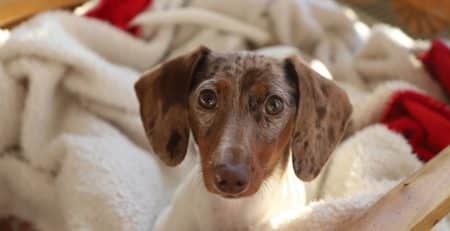Hip Dysplasia
What is Hip Dysplasia?
Hip dysplasia is a serious problem that affects many dogs. It’s one of the most common skeletal diseases seen in dogs.
Hip dysplasia affects the hip joint, which joins the hind leg to the body. This is a ball and socket joint, and normally the ball rotates freely within the joint. Strong ligaments hold the bones together, and cartilage acts as a cushion within the joint.
In a dog with hip dysplasia, the joint is poorly formed, and/or the ligaments, muscles and connective tissue associated with the joint are weaker. The surfaces of the bones begin to lose contact with each other (a condition called subluxation). This alters the size and shape of the surfaces where the two bones touch each other.
A dog may be born with normal hips, but may develop subluxation as the dog ages (often due to hereditary problems), leading to hip dysplasia in one or both hips. It can develop as early as four months old (early onset). There is also a late onset form where hip dysplasia leads to osteoarthritis, which leads to degeneration of the joint cartilage.
Dogs prone to hip dysplasia
Certain breeds are very prone to this condition, including large dogs such as the German Shepherd, Labrador Retriever, Great Dane, and Saint Bernard. Not all large dogs get hip dysplasia: dogs such as Greyhounds and Borzoi rarely suffer from the condition. Smaller breeds may also be affected, but they often do not show clinical symptoms.
Obesity also puts a dog at risk of hip dysplasia. Extra weight can damage joints or increase the rate of their degeneration. Puppies that grow very quickly are also at risk, especially if this growth happens between three to ten months of age. A diet lacking in calcium and other important minerals also puts dogs at risk.
Too much exercise at a young age puts strain on the dog’s joints. Moderate exercise such as running and swimming is beneficial, but activities such as playing Frisbee can put excess strain on the joints.
Symptoms
In the early stages of the disease, any symptoms will be linked to the looseness of the joint. As the disease progresses, the symptoms will be related to joint degeneration and osteoarthritis.
A dog suffering from hip dysplasia will be less willing to get up and move, especially movements such as running, jumping or climbing steps. The dog may begin to hop, swap or otherwise appear lame in the hind legs, especially after exercise. The lameness is due to pain in the dog’s hip joint.
As the disease worsens, the hip joint loses its range of motion. There will usually be loss of muscle in the thigh area, but increased muscle gain in the shoulder area as the dog shifts more weight to its front legs.
A vet will diagnose hip dysplasia if the dog shows these symptoms, but will also need to perform a full physical examination, and use x-rays to confirm the diagnosis. Often the vet will feel looseness in the joint, or the dog will show pain when the hind leg is flexed and extended.
Treatment
There are non-surgical and surgical options available to treat hip dysplasia. The dog needs to go on a diet designed to maintain a healthy weight or to lose excess weight. An affected dog often needs supplements to support and repair the joint cartilage. If the dog is in pain, the vet may also prescribe analgesic medicines.
If none of these treatments are effective, surgery may be needed. There are various operations to treat the condition.
A Femoral head osteotomy (FHO) involves removing the ball part of the joint. A false but functional joint should form as a result.
A Triple osteotomy involves cutting the pelvis in three places around the hip joint, then the bone is rotated to help the ball part of the joint fit into the socket better. This option is best for younger dogs that have not begun to develop arthritis.
A Total Hip Replacement (THR) replaces the ball and socket joint with an artificial joint made of plastic and stainless steel. This is often a last resort as it is a major operation requiring highly specialised knowledge.
Prevention
Selective breeding is perhaps the only effective method of preventing hip dysplasia. If healthy parents with good joints breed, it results in puppies that are highly unlikely to develop hip dysplasia.
However, if you’re beloved dog is at risk of developing hip dysplasia, there are a few things you can do to prevent the onset of the condition.
Make sure your dog isn’t obese or overweight. Consult with your vet to make sure you are feeding the correct diet for his age and breed. It is especially important to feed puppies correctly. You want to try to avoid sudden growth spurts or weight gain.
You should do your best avoid strenuous exercise for puppies and young dogs. Try to discourage them from jumping very high or standing on their hind legs, as this puts strain on their joints. Think of them like kids: you wouldn’t ask a child to do manual labour!
Moderate exercise such as swimming and jogging will help develop muscle without putting excessive strain on the joints. A dog already affected with hip dysplasia may benefit from swimming, because he’ll be able to exercise and build muscle without straining his hips. A more mature and fitter dog should be able to cope with more strenuous exercise.
Adjust your dog’s exercise routine as he ages. Try to slowly reduce the amount of exercise your dog does, or do frequent but gentle exercise.





















